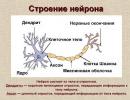How much water is contained in the cell. water regime. Tasks for groups of students
Water is the most common compound on Earth and in living organisms. The water content in cells depends on the nature of metabolic processes: the more intense they are, the higher the water content.
On average, the cells of an adult human contain 60-70% water. With the loss of 20% of water, organisms die. Without water, a person can live no more than 7 days, while without food no more than 40 days.

Rice. 4.1. The spatial structure of the water molecule (H 2 O) and the formation of a hydrogen bond
The water molecule (H 2 O) consists of two hydrogen atoms that are covalently bonded to oxygen atoms. The molecule is polar because it is bent at an angle and the nucleus of the oxygen atom pulls the shared electrons to this angle, so that the oxygen acquires a partial negative charge, and the hydrogen atoms at the open ends become partially positive charges. Water molecules can be attracted to each other by positive and negative charges, forming hydrogen bond (Fig.4.1.).
Thanks to unique structure water molecules and their ability to bind to each other using hydrogen bonds, water has a number of properties that determine its important role in the cell and organism.
Hydrogen bonds cause relatively high boiling and evaporation temperatures, high heat capacity and thermal conductivity of water, and the property of a universal solvent.
Hydrogen bonds are 15-20 times weaker than covalent ones. In the liquid state, hydrogen bonds are either formed or broken, which causes the movement of water molecules, its fluidity.
The biological role of H 2 O
Water determines physical properties cells - its volume, elasticity (turgor). The cell contains 95-96% free water and 4-5% bound. Bound water forms aqueous (solvate) shells around certain compounds (for example, proteins), preventing their interaction with each other.
free water is a good solvent for many inorganic and organic polar substances. Substances that are highly soluble in water are called hydrophilic. For example, alcohols, acids, gases, most salts of Sodium, Potassium, etc. For hydrophilic substances, the binding energy between their atoms is less than the energy of attraction of these atoms to water molecules. Therefore, their molecules or ions are easily integrated into the general system of hydrogen bonds of water.
Water as a universal solvent plays an extremely important role, since most chemical reactions occurs in aqueous solutions. The penetration of substances into the cell and the removal of waste products from it in most cases is possible only in dissolved form.
Water does not dissolve non-polar (non-charged) substances, since it cannot form hydrogen bonds with them. Substances that are insoluble in water are called hydrophobic . These include fats, fat-like substances, polysaccharides, rubber.
Some organic molecules have dual properties: in some areas they are polar groups, and in others - non-polar. Such substances are called amphipathic, or amphiphilic. These include proteins, fatty acids, phospholipids, nucleic acids. Amphiphilic compounds play an important role in the organization of biological membranes, complex supramolecular structures.
Water is directly involved in the reactions hydrolysis- breakdown of organic compounds. At the same time, under the action of special enzymes, OH ions are added to the free valences of organic molecules. - and H + water. As a result, they form new substances with new properties.
Water has a high heat capacity (i.e., the ability to absorb heat with minor changes in its own temperature) and good thermal conductivity. Due to these properties, the temperature inside the cell (and the body) is maintained at a certain level with significant changes in ambient temperature.
Important biological significance for the functioning of plants, cold-blooded animals has the fact that under the influence of dissolved substances (carbohydrates, glycerol) water can change its properties, in particular the freezing and boiling points.
The properties of water are so important for living organisms that it is impossible to imagine the existence of life, as we know it, not only on Earth, but on any other planet without an adequate supply of water.
MINERAL SALT
They can be in a dissolved or undissolved state. Molecules of mineral salts in an aqueous solution decompose into cations and anions.
The water content in various plant organs varies within fairly wide limits. It varies depending on environmental conditions, age and type of plants. Thus, the water content in lettuce leaves is 93-95%, corn - 75-77%. The amount of water is not the same in different organs of plants: sunflower leaves contain 80-83% of water, stems - 87-89%, roots - 73-75%. The water content, equal to 6-11%, is typical mainly for air-dry seeds, in which vital processes are inhibited.
Water is contained in living cells, in the dead elements of the xylem and in the intercellular spaces. In the intercellular spaces, water is in a vapor state. Leaves are the main evaporating organs of a plant. In this regard, it is natural that the largest amount of water fills the intercellular spaces of the leaves. In a liquid state, water is found in various parts of the cell: cell membrane, vacuole, cytoplasm. Vacuoles are the most water-rich part of the cell, where its content reaches 98%. At the highest water content, the water content in the cytoplasm is 95%. The lowest water content is characteristic of cell membranes. Quantitative determination of water content in cell membranes is difficult; apparently, it ranges from 30 to 50%.
Shapes of water in different parts plant cell are also different. The vacuolar cell sap is dominated by water retained by relatively low molecular weight compounds (osmotically bound) and free water. In the shell of a plant cell, water is mainly bound by high-polymer compounds (cellulose, hemicellulose, pectin substances), i.e., colloidally bound water. In the cytoplasm itself there is free water, colloidally and osmotically bound. Water located at a distance of up to 1 nm from the surface of a protein molecule is firmly bound and does not have a regular hexagonal structure (colloidal-bound water). In addition, there is a certain amount of ions in the cytoplasm, and, consequently, part of the water is osmotically bound.
The physiological significance of free and bound water is different. According to most researchers, the intensity of physiological processes, including growth rates, depends primarily on the content of free water. There is a direct correlation between the content of bound water and the resistance of plants to adverse external conditions. These physiological correlations are not always observed.
For their normal existence, cells and the plant organism as a whole must contain a certain amount of water. However, this is easily feasible only for plants growing in water. For land plants, this task is complicated by the fact that water in the plant organism is continuously lost in the process of evaporation. Evaporation of water by the plant reaches enormous proportions. An example can be given: one corn plant evaporates up to 180 kg of water during the growing season, and 1 hectare of forest in South America evaporates an average of 75 thousand kg of water per day. The huge water consumption is due to the fact that most plants have a significant leaf surface located in an atmosphere that is not saturated with water vapor. At the same time, the development of an extensive leaf surface is necessary and developed in the course of a long evolution to ensure normal nutrition with carbon dioxide contained in the air in an insignificant concentration (0.03%). In his famous book "The fight of plants against drought" K.A. Timiryazev pointed out that the contradiction between the need to capture carbon dioxide and reduce water consumption left an imprint on the structure of the entire plant organism.
In order to compensate for the loss of water during evaporation, a large amount of it must continuously enter the plant. Two processes continuously going on in a plant - the inflow and evaporation of water - are called plant water balance. For the normal growth and development of plants, it is necessary that the water consumption approximately correspond to the income, or, in other words, that the plant reduces its water balance without a large deficit. To do this, in the process of natural selection, the plant developed adaptations for water absorption (a colossally developed root system), for the movement of water (a special conductive system), and for reducing evaporation (the system of integumentary tissues and the system of automatically closing stomatal openings).
Despite all these adaptations, a water deficit is often observed in the plant, i.e., the intake of water is not balanced by its consumption in the process of transpiration.
Physiological disturbances occur in different plants with varying degrees of water deficiency. There are plants that have developed in the process of evolution various adaptations to tolerate dehydration (drought-resistant plants). The elucidation of the physiological characteristics that determine the resistance of plants to a lack of water is a most important task, the solution of which is of great not only theoretical, but also agricultural practical importance. At the same time, in order to solve it, knowledge of all aspects of the water exchange of a plant organism is necessary.
1. What is the structure of water?
Answer. The water molecule has an angular structure: its constituent nuclei form isosceles triangle, which has two hydrogens at its base and an oxygen atom at its apex. Internuclear O-N distances close to 0.1 nm, the distance between the nuclei of hydrogen atoms is 0.15 nm. Of the six electrons that make up the outer electron layer of the oxygen atom in the water molecule, two electron pairs form covalent O-N connections, and the remaining four electrons are two unshared electron pairs.
The water molecule is a small dipole containing positive and negative charges at the poles. Near the hydrogen nuclei there is a lack of electron density, and on opposite side molecules, near the oxygen nucleus, there is an excess of electron density. It is this structure that determines the polarity of the water molecule.
2. What is the amount of water (in%) contained in different cells?
The amount of water varies in different tissues and organs. So, in a person in the gray matter of the brain, its content is 85%, and in the bone tissue - 22%. The highest water content in the body is observed in the embryonic period (95%) and gradually decreases with age.
The water content in various plant organs varies within fairly wide limits. It varies depending on environmental conditions, age and type of plants. Thus, the water content in lettuce leaves is 93-95%, corn - 75-77%. The amount of water is not the same in different organs of plants: sunflower leaves contain 80-83% of water, stems - 87-89%, roots - 73-75%. The water content, equal to 6-11%, is typical mainly for air-dry seeds, in which vital processes are inhibited. Water is contained in living cells, in the dead elements of the xylem and in the intercellular spaces. In the intercellular spaces, water is in a vapor state. Leaves are the main evaporating organs of a plant. In this regard, it is natural that the largest amount of water fills the intercellular spaces of the leaves. In a liquid state, water is found in various parts of the cell: cell membrane, vacuole, cytoplasm. Vacuoles are the most water-rich part of the cell, where its content reaches 98%. At the highest water content, the water content in the cytoplasm is 95%. The lowest water content is characteristic of cell membranes. Quantitative determination of water content in cell membranes is difficult; apparently, it ranges from 30 to 50%. The forms of water in different parts of the plant cell are also different.
3. What is the role of water in living organisms?
Answer. Water is the predominant component of all living organisms. It has unique properties due to structural features: water molecules have the form of a dipole and hydrogen bonds form between them. The average water content in the cells of most living organisms is about 70%. Water in the cell is present in two forms: free (95% of all cell water) and bound (4-5% associated with proteins).
Water functions:
1. Water as a solvent. Many chemical reactions in the cell are ionic, and therefore proceed only in aquatic environment. Substances that dissolve in water are called hydrophilic (alcohols, sugars, aldehydes, amino acids), insoluble - hydrophobic (fatty acids, cellulose).
2. Water as a reagent. Water is involved in many chemical reactions: polymerization reactions, hydrolysis, in the process of photosynthesis.
3. Transport function. Movement through the body along with water of substances dissolved in it to its various parts and the removal of unnecessary products from the body.
4. Water as a heat stabilizer and thermostat. This function is due to such properties of water as high heat capacity - it softens the effect on the body of significant temperature changes in the environment; high thermal conductivity - allows the body to maintain the same temperature throughout its volume; high heat of evaporation - used to cool the body during sweating in mammals and transpiration in plants.
5. Structural function. The cytoplasm of cells contains from 60 to 95% water, and it is she who gives the cells their normal shape. In plants, water maintains turgor (the elasticity of the endoplasmic membrane), in some animals it serves as a hydrostatic skeleton (jellyfish)
Questions after § 7
1. What is the peculiarity of the structure of the water molecule?
Answer. Unique properties water is determined by the structure of its molecule. The water molecule consists of an O atom bonded to two H atoms by polar covalent bonds. The characteristic arrangement of electrons in a water molecule gives it an electrical asymmetry. The more electronegative oxygen atom attracts the electrons of the hydrogen atoms more strongly, as a result, the common pairs of electrons in the water molecule are shifted towards it. Therefore, although the water molecule as a whole is not charged, each of the two hydrogen atoms has a partially positive charge (denoted 8+), and the oxygen atom carries a partially negative charge (8-). The water molecule is polarized and is a dipole (has two poles).
The partially negative charge of the oxygen atom of one water molecule is attracted partially positive atoms hydrogen of other molecules. Thus, each water molecule tends to hydrogen bond with four neighboring water molecules.
2. What is the importance of water as a solvent?
Answer. Due to the polarity of molecules and the ability to form hydrogen bonds, water easily dissolves ionic compounds (salts, acids, bases). Well soluble in water and some non-ionic, but polar compounds, i.e., in the molecule of which there are charged (polar) groups, such as sugars, simple alcohols, amino acids. Substances that are highly soluble in water are called hydrophilic (from the Greek hygros - wet and philia - friendship, inclination). When a substance goes into solution, its molecules or ions can move more freely and, therefore, the reactivity of the substance increases. This explains why water is the main medium in which most chemical reactions take place, and all hydrolysis reactions and numerous redox reactions take place with the direct participation of water.
Substances that are poorly or completely insoluble in water are called hydrophobic (from the Greek phobos - fear). These include fats, nucleic acids, some proteins, and polysaccharides. Such substances can form interfaces with water, on which many chemical reactions take place. Therefore, the fact that water does not dissolve non-polar substances is also very important for living organisms. Among the physiologically important properties of water is its ability to dissolve gases (O2, CO2, etc.).
3. What is the thermal conductivity and heat capacity of water?
Answer. Water has a high heat capacity, i.e., the ability to absorb thermal energy with a minimal increase in its own temperature. The high heat capacity of water protects the tissues of the body from a rapid and strong increase in temperature. Many organisms cool themselves by evaporating water (transpiration in plants, sweating in animals).
4. Why is it considered that water is an ideal liquid for a cell?
Answer. The high content of water in the cell is the most important condition for its activity. With the loss of most of the water, many organisms die, and a number of unicellular and even multicellular organisms temporarily lose all signs of life. This state is called suspended animation. After hydration, the cells wake up and become active again.
The water molecule is electrically neutral. But the electric charge inside the molecule is unevenly distributed: in the region of hydrogen atoms (more precisely, protons), a positive charge prevails, in the region where oxygen is located, the negative charge density is higher. Therefore, a particle of water is a dipole. The dipole property of a water molecule explains its ability to orient itself in an electric field, to attach to various molecules and sections of molecules that carry a charge. As a result, hydrates are formed. The ability of water to form hydrates is due to its universal dissolving properties. If the energy of attraction of water molecules to the molecules of a substance is greater than the energy of attraction between water molecules, then the substance dissolves. Depending on this, hydrophilic (Greek hydros - water and phileo - love) substances are distinguished, which are highly soluble in water (for example, salts, alkalis, acids, etc.), and hydrophobic (Greek hydros - water and phobos - fear) substances, hardly or not at all soluble in water (fats, fat-like substances, rubber, etc.). The composition of cell membranes includes fat-like substances that limit the transition from outdoor environment to cells and back, and from one part of the cell to another.
Most of the reactions that take place in a cell can only take place in an aqueous solution. Water is a direct participant in many reactions. For example, the breakdown of proteins, carbohydrates and other substances occurs as a result of their interaction with water catalyzed by enzymes. Such reactions are called hydrolysis reactions (Greek hydros - water and lysis - splitting).
Water has a high heat capacity and at the same time relatively high thermal conductivity for liquids. These properties make water an ideal liquid for maintaining the thermal balance of the cell and organism.
Water is the main environment for the flow of biochemical reactions of the cell. It is a source of oxygen released during photosynthesis, and hydrogen, which is used to restore assimilation products. carbon dioxide. And finally, water is the main means of transporting substances in the body (blood and lymph flow, ascending and descending currents of solutions through the vessels of plants) and in the cell.
5. What is the role of water in the cell
Ensuring cell elasticity. The consequences of the loss of water by the cell are wilting of leaves, drying of fruits;
Acceleration of chemical reactions due to the dissolution of substances in water;
Ensuring the movement of substances: the entry of most substances into the cell and their removal from the cell in the form of solutions;
Ensuring the dissolution of many chemicals (a number of salts, sugars);
Participation in a number of chemical reactions;
Participation in the process of thermoregulation due to the ability to slow heating and slow cooling.
6. What structural and physico-chemical properties of water determine it biological role in a cage?
Answer. Structural physical and chemical properties of water determine its biological functions.
Water is a good solvent. Due to the polarity of molecules and the ability to form hydrogen bonds, water easily dissolves ionic compounds (salts, acids, bases).
Water has a high heat capacity, i.e., the ability to absorb thermal energy with a minimal increase in its own temperature. The high heat capacity of water protects the tissues of the body from a rapid and strong increase in temperature. Many organisms cool themselves by evaporating water (transpiration in plants, sweating in animals).
Water also has a high thermal conductivity, ensuring an even distribution of heat throughout the body. Consequently, the high specific heat capacity and high thermal conductivity make water an ideal liquid for maintaining the thermal equilibrium of the cell and organism.
Water practically does not compress, creating turgor pressure, determining the volume and elasticity of cells and tissues. So, it is the hydrostatic skeleton that maintains the shape of roundworms, jellyfish and other organisms.
Water is characterized by optimal biological systems strength value surface tension, which arises due to the formation of hydrogen bonds between water molecules and molecules of other substances. Due to the force of surface tension, capillary blood flow occurs, ascending and descending currents of solutions in plants.
In certain biochemical processes, water acts as a substrate.






